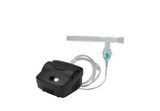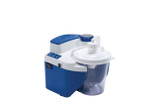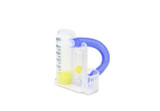Respiratory Care
Explore Our Full Range of Respiratory Therapy Supplies
If you're managing a respiratory condition at home, the right supplies can make breathing easier and life more comfortable. Whether you're looking for a reliable nebulizer, daily trach care products, or a backup suction machine, we’re here to help, we’re here to help with a full complement of respiratory therapy supplies.
Explore Our Full Range of Respiratory Therapy Supplies
If you're managing a respiratory condition at home, the right supplies can make breathing easier and life more comfortable. Whether you're looking for a reliable nebulizer, daily trach care products, or a backup suction machine, we’re here to help, we’re here to help with a full complement of respiratory therapy supplies.
Express Medical Supply ships fast from our St. Louis warehouse, and our customer service team is trained to help you choose the right tools for your needs. Our selection includes trusted home medical equipment to support long-term respiratory care with confidence.
Nebulizer Supplies
Nebulizers deliver medication in the form of a mist, making it easier to inhale deeply, especially if you struggle with inhalers. They’re commonly used for asthma, bronchitis, and other chronic lung conditions.
- No timing required. Just breathe normally
- Effective for children, older adults, or anyone with limited lung strength
- Compatible with various masks, tubing, and mouthpieces
Need something easy to travel with? The DeVilbiss Traveler is lightweight and dependable. For home use, reusable kits like the PARI LC Plus are a customer favorite.
Nebulizers are a staple in many home care respiratory equipment routines because they’re simple to set up and essential for daily relief. Please see our blog for instructions on how to clean your nebulizer.
Understanding Suction Machines
Suction machines help clear the airway when coughing isn’t enough. This can be vital for patients with limited mobility, neuromuscular disorders, or a tracheostomy. These machines:
- Remove mucus, saliva, or secretions that obstruct breathing
- Lower risk of pneumonia and respiratory infection
- Support recovery after surgery or illness
- Help manage long-term tracheostomy care at home
The Medline Vac-Assist is a portable suction machine designed for intermittent use, offering adjustable pressure up to 560 mmHg, a quiet motor, and an 800cc canister for efficient fluid collection.
Suction machines aren’t just emergency tools. They’re everyday solutions for long-term comfort.
Make Inhalers More Effective with Spacers
An inhaler spacer is a small chamber that helps get more medicine into your lungs and less stuck in your throat. They're often overlooked but they make a big difference in treatment results.
Inhaler spacers are especially helpful for:
- Pediatric use for kids who are just learning how to use an inhaler
- Seniors with poor breath control
- Anyone who coughs or struggles to coordinate inhaler timing
- Reducing waste and improving medication absorption
The Aerochamber Monaghan Z Stat Inhaler Spacer sets a higher standard for inhaler spacers. Its anti-static chamber enhances drug delivery, while the integrated valve and baffle system improves aerosol flow. A built-in flow signal whistle encourages proper inhalation speed, helping users get the most from each dose. Latex-free and easy to clean, it’s a reliable way to improve medication delivery without replacing your inhaler.
Oxygen Supplies for Everyday Comfort
For people who rely on supplemental oxygen, the right accessories make all the difference. We carry oxygen tubing, humidifiers, cannulas, and connectors so you can create a setup that’s comfortable and dependable.
A few customer favorites include:
- Salter Labs Soft Nasal Cannulas for comfort
- Bubble humidifiers that prevent lung tissue from drying out
- High-quality oxygen tubing to support flexible at-home setups
With the right gear, respiratory devices become easier to use at home, on the move, or during recovery.
Track Lung Health with Respiration Monitors
Sometimes it’s not about treatment and rather about tracking.
With the right monitors, you can stay ahead of symptoms and respond faster to changes. Whether managing asthma or recovering from surgery, knowing your numbers gives you peace of mind.
- Peak flow meters help monitor lung strength
- Incentive spirometers promote deep breathing post-surgery
- Pulse oximeters instantly show your blood oxygen levels
Devices like the Truzone Peak Flow Meter and ChoiceMMed Fingertip Pulse Oximeter are small but powerful. They're a smart part of any durable medical equipment kit at home.
Why Shop Respiratory Equipment with Express Medical Supply?
Since 1994, Express Medical Supply has helped thousands of people find the right tools for better breathing, greater comfort, and easier daily care. Whether you’re buying a nebulizer for the first time or restocking tracheostomy supplies, we ship fast, double-check every order, and only carry healthcare products we’d recommend to our own families.
Have questions? Need help deciding? Call us at 1-800-633-2139. We’re here to make home respiratory care less stressful.
Frequently Asked Questions
What kinds of conditions are respiratory supplies used for?
Respiratory supplies are used to manage a wide range of conditions like asthma, COPD, sleep apnea, and recovery from surgery or illness. They support breathing, medication delivery, airway clearance, and oxygen therapy, whether short-term or ongoing.
How often should I replace my respiratory supplies?
It depends on the item. Tubing is usually replaced every 2–4 weeks. Masks, spacers, and chambers may last a few months with regular cleaning. Always check for signs of wear and if something looks discolored, cracked, or stiff, it’s time to replace it.
Do I need to clean saline or sterile water containers after use?
No. Single-dose products like saline bullets are meant to be used once and discarded. Multi-use bottles should stay sealed between uses and never be touched to other surfaces. Never reuse containers not meant for it.
What are the signs that my oxygen supplies need updating?
If you notice airflow issues, drying or irritation, or visible damage to tubing or cannulas, it’s probably time to replace them. Swapping out older accessories helps maintain consistent, safe treatment.
Is it safe to use respiratory devices without medical training?
Yes—most products we carry are designed for safe home use. Devices like nebulizers, suction machines, and oxygen accessories come with instructions and are made to be simple and intuitive. Still unsure? Our support team can walk you through setup questions.







